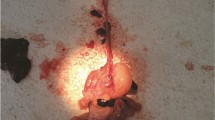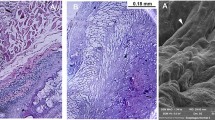Abstract
Background
Although several materials have been used to replace the esophagus, none of the materials appears to be feasible for clinical use. Our group has developed a bioabsorbable polymer that can be used to repair the defects of stomach, small intestine, biliary tract, and veins. In this study, we implanted a bioabsorbable polymer patch (BAPP) into an esophageal defect and we investigated the clinical utility of BAPP and evaluated the process of esophageal regeneration.
Methods
Pigs (n = 9) underwent right thoracotomy under general anesthesia. A 4 × 2-cm oval-shaped portion of the esophageal wall was excised, and a BAPP was implanted at the excision site. Esophageal endoscopy was performed at 2 weeks after the implantation. At 4, 8, and 12 weeks after implantation, the whole esophagus was resected for gross and histological examinations of the graft sites.
Result
Esophageal endoscopy at 2 weeks revealed a tiny ulceration at the implantation site with no stenosis. At 4 weeks, the epithelium at the graft site was similar to that of the native esophagus, but it lacked a proper muscle layer. At 8 weeks, a rough muscle layer had developed. At 12 weeks, normal mucosa and a proper muscle layer similar to that of the native wall were confirmed.
Conclusion
BAPP repaired the defective esophageal wall without complications, and a neo esophageal wall identical to the native esophageal wall had formed by 12 weeks after implantation. Hence, this newly designed substitute has the potential for application as a novel treatment for defective esophagus.









Similar content being viewed by others
References
Aikawa M, Miyazawa M, Okada K, Torii T, Toshimitsu Y, Okamoto K, et al. Gastric wall regeneration using bioabsorbable polymer. Jpn J Gastroenterol Surg. 2009;42:139.
Aikawa M, Miyazawa M, Okamoto K, Toshimitsu Y, Torii T, Okada K, et al. A novel treatment for bile duct injury with a tissue-engineered bioabsorbable polymer patch. Surgery. 2010;147:575–80.
Miyazawa M, Aikawa M, Okada K, Toshimitsu Y, Okamoto K, Koyama I, et al. Regeneration of extrahepatic bile ducts by tissue engineering with a bioabsorbable polymer. J Artif Organs. 2012;15:26–31.
Toshimitsu Y, Miyazawa M, Torii T, Koyama I, Ikada Y. Tissue-engineered patch for the reconstruction of inferior vena cava during living-donor liver transplantation. J Gastrointest Surg. 2005;9:789–93.
Shin’oka T, Imai Y, Ikada Y. Transplantation of a tissue-engineered pulmonary artery. N Engl J Med. 2001;344:532–3.
Linden PA, Bueno R, Mentzer SJ, Zellos L, Lebenthal A, Colson YL, et al. Modified T-tube repair of delayed esophageal perforation results in a low mortality rate similar to that seen with acute perforations. Ann Thorac Surg. 2007;83:1129–33.
Wright CD, Mathisen DJ, Wain JC, Moncure AC, Hilgenberg AD, Grillo HC. Reinforced primary repair of thoracic esophageal perforation. Ann Thorac Surg. 1995;60:245–8 (discussion 48–9).
Coran AG. Pericardioesophagoplasty. A new operation for partial esophageal replacement. Am J Surg. 1973;125:294–9.
Grillo HC, Wilkins EW Jr. Esophageal repair following late diagnosis of intrathoracic perforation. Ann Thorac Surg. 1975;20:387–99.
Jara FM. Diaphragmatic pedicle flap for treatment of Boerhaave’s syndrome. J Thorac Cardiovasc Surg. 1979;78:931–3.
Dooling JA, Zick HR. Closure of an esophagopleural fistula using onlay intercostal pedicle graft. Ann Thorac Surg. 1967;3:553–7.
Iannettoni MD, Vlessis AA, Whyte RI, Orringer MB. Functional outcome after surgical treatment of esophageal perforation. Ann Thorac Surg. 1997;64:1606–9 (discussion 9–10).
Richardson JD. Management of esophageal perforations: the value of aggressive surgical treatment. Am J Surg. 2005;190:161–5.
Fuchs JR, Nasseri BA, Vacanti JP. Tissue engineering: a 21st century solution to surgical reconstruction. Ann Thorac Surg. 2001;72:577–91.
Berman EF. The experimental replacement of portions of the esophagus by a plastic tube. Ann Surg. 1952;135:337–43.
Fukushima M, Kako N, Chiba K, Kawaguchi T, Kimura Y, Sato M, et al. Seven-year follow-up study after the replacement of the esophagus with an artificial esophagus in the dog. Surgery. 1983;93:70–7.
Gonzalez Saez LA, Arnal Monreal F, Pita Fernandez S, Machuca Santa Cruz J. Experimental study using PTFE (Goretex) patches for replacement of the oesophageal wall. Eur Surg Res. 2003;35:372–6.
Lopes MF, Cabrita A, Ilharco J, Pessa P, Paiva-Carvalho J, Pires A, et al. Esophageal replacement in rat using porcine intestinal submucosa as a patch or a tube-shaped graft. Dis Esophagus. 2006;19:254–9.
Jonsson L, Gatzinsky V, Jennische E, Johansson C, Nannmark U, Friberg LG. Piglet model for studying esophageal regrowth after resection and interposition of a silicone stented small intestinal submucosa tube. Eur Surg Res. 2011;46:169–79.
Nakase Y, Nakamura T, Kin S, Nakashima S, Yoshikawa T, Kuriu Y, et al. Intrathoracic esophageal replacement by in situ tissue-engineered esophagus. J Thorac Cardiovasc Surg. 2008;136:850–9.
Freud E, Greif M, Rozner M, Finaly R, Efrati I, Kidron D, et al. Bridging of esophageal defects with lyophilized dura mater: an experimental study. J Pediatr Surg. 1993;28:986–9.
Purushotham AD, Carachi R, Gorham SD, French DA, Shivas AA. Use of a collagen coated vicryl tube in reconstruction of the porcine esophagus. Eur J Pediatr Surg. 1991;1:80–4.
Yamamoto Y, Nakamura T, Shimizu Y, Matsumoto K, Takimoto Y, Kiyotani T, et al. Intrathoracic esophageal replacement in the dog with the use of an artificial esophagus composed of a collagen sponge with a double-layered silicone tube. J Thorac Cardiovasc Surg. 1999;118:276–86.
Yamamoto Y, Nakamura T, Shimizu Y, Takimoto Y, Matsumoto K, Kiyotani T, et al. Experimental replacement of the thoracic esophagus with a bioabsorbable collagen sponge scaffold supported by a silicone stent in dogs. ASAIO J. 1999;45:311–6.
Badylak SF, Vorp DA, Spievack AR, Simmons-Byrd A, Hanke J, Freytes DO, et al. Esophageal reconstruction with ECM and muscle tissue in a dog model. J Surg Res. 2005;128:87–97.
Grikscheit T, Ochoa ER, Srinivasan A, Gaissert H, Vacanti JP. Tissue-engineered esophagus: experimental substitution by onlay patch or interposition. J Thorac Cardiovasc Surg. 2003;126:537–44.
Nonaka K, Miyazawa M, Aikawa M, Akimoto N, Koyama I, Ikada Y, et al. Experimental trial for perforation caused by esophageal endoscopic submucosal dissection using a biodegradable polymer stent in an animal model. Dig Endosc. 2012;24:286.
Andoh A, Bamba S, Brittan M, Fujiyama Y, Wright NA. Role of intestinal subepithelial myofibroblasts in inflammation and regenerative response in the gut. Pharmacol Ther. 2007;114:94–106.
Powell DW, Mifflin RC, Valentich JD, Crowe SE, Saada JI, West AB. Myofibroblasts. II. Intestinal subepithelial myofibroblasts. Am J Physiol. 1999;277:C183–201.
Langer R, Vacanti JP. Tissue engineering. Science. 1993;260:920–6.
Acknowledgments
This study was supported by grants from the Gastrointestinal Cancer Project funded by Nakayama Cancer Research Institute and Grant-in-Aid for Scientific Research (KAKEN C) in Japan.
Conflict of interest
The authors declare that they have no conflict of interest.
Author information
Authors and Affiliations
Corresponding author
Rights and permissions
About this article
Cite this article
Aikawa, M., Miyazawa, M., Okamoto, K. et al. A bioabsorbable polymer patch for the treatment of esophageal defect in a porcine model. J Gastroenterol 48, 822–829 (2013). https://doi.org/10.1007/s00535-012-0716-7
Received:
Accepted:
Published:
Issue Date:
DOI: https://doi.org/10.1007/s00535-012-0716-7




